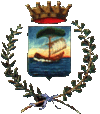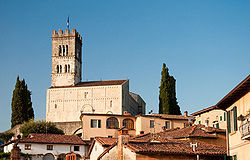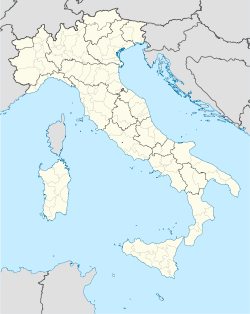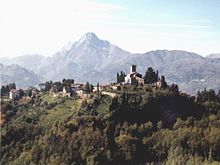- Barga
-
This article is about a city in Italy. For the ethnic group of the Mongols, see Barga Mongol. For the landscape in Inner Mongolia/Manchuria, see Hulunbuir.
Barga — Comune — Comune di Barga Barga Cathedral. 
Coat of armsLocation of Barga in Italy Coordinates: 44°04′30″N 10°28′54″E / 44.075°N 10.48167°E Country Italy Region Tuscany Province Lucca (LU) Frazioni Sommocolonia, Filecchio, Fornaci di Barga, Mologno, Ponte all'Ania, Tiglio, Renaio Government - Mayor Marco Bonini (Democratic Party) Area - Total 66 km2 (25.5 sq mi) Elevation 410 m (1,345 ft) Population (31 December 2010[1]) - Total 10,327 - Density 156.5/km2 (405.3/sq mi) Demonym Barghigiani Time zone CET (UTC+1) - Summer (DST) CEST (UTC+2) Postal code 55051 Dialing code 0583 Patron saint St. Christopher Saint day July 25 Website Official website Barga is a medieval town and comune of the province of Lucca in Tuscany, central Italy. It is home to around 10,000 people and is the chief town of the "Media Valle" (mid valley) of the Serchio.
Contents
Geography
Barga lies 35 km north of the provincial capital, Lucca. It is overlooked by the village of Albiano, a località of Barga, which in the 10th century was the site of a castle protecting the town.
Pania della Croce, a mountain of the Apuan Alps, dominates the surrounding chestnut trees, grape vines and olive groves.
History
Founded by the Lombards, the city grew as a castle surrounded by a line of walls, of which two gates (Porta Reale and Porta Macchiaia) have survived. The town was well known during the Middle Ages for the manufacture of silk threads which were exported to major centres such as Florence, its mills powered by the hydraulic power of the nearby creeks. In the Middle Ages, Lucca and Pisa battled frequently to conquer the wealthy town and the surrounding territory, and for a time Barga was part of the Florentine dominion, later Duchy and Grand Duchy of Tuscany. In 1847 it became part of the Duchy of Lucca, maintaining a certain degree of autonomy, until it became part of the Kingdom of Italy in 1861. Between 1331 and 1859 Albiano owed its allegiance to the Florentine State.[citation needed] The region was part of the Gothic Line in World War II, and was the scene of fierce fighting between the Allies and Germans from October 1944 until April 1945.
Main sights
Main sights include:
- Duomo (cathedral) (11th-16th centuries), the main example of Romanesque architecture in the Serchio Valley. Of the original church, built in local limestone, parts of the façade remain. The interior has a nave and two aisles. It houses a large (3.5 m) wooden statue of St. Christopher, patron of the city. The pulpit (12th century) was designed by Guido Bigarelli da Como, with four red marble columns resting on lion sculptures. The campanile contains three bells, the oldest of which dates to the 16th century.
- Arringo, a large lawn between the Duomo and the Palazzo Pretorio
- Loggia del Podestà (14th century).
- Church of San Francesco, with several works by Andrea della Robbia
Culture
There is an annual international opera festival, called "Opera Barga Festival", and a long running and very successful jazz festival, "Bargajazz". Recently, Barga has become the home of many painters, including John Bellany who exhibit their work in some of the small galleries within the castle walls. The "Sagra" is a feature of Tuscan rural culture; communal meals for several hundred people, eaten in the open air, often in orchards, vineyards or sports grounds. Originally religious celebrations, they are now often used to raise funds for local causes. Each town and village will have its own peculiar sagra: Around Barga from July to September it is possible to participate in a Sagra every night. In Barga itself there is the "Cena in Vignola" in the vineyard below the Duomo, and in August the "Sagra delle pesce e Patate" (Fish and Chips) in celebration of the Barga/Scottish connection. At nearby San Pietro in Campo, there is the "Sagra del Maiale" (Pork), at Filecchio the "Sagra della Polenta e Ucelli" (originally small wild birds, now pheasant), at Fornaci di Barga the "1°Maggio expo".
The Italian Touring Club has recently assigned the "orange flag" of the "Migliori borghi d'Italia" ("Best Villages of Italy"), a distinguished sign recognizing the peculiarity of its beauty and of its quality. Barga has also been, since 1999, the home of the "European Gnome Sanctuary" run by the Garden Gnome Liberation Front.
The frazione of Castelvecchio Pascoli was home to one of Italy's 19th century poet Giovanni Pascoli.
In 2008 Barga became the first medieval historic centre in Italy to be mapped and equipped with QR codes (2D barcodes) for all of the churches, palazzo's statues, restaurants, bars and places of interest. After a two year trial, the project was released to the public in Dec 2010 under the name iBarga. Visitors can now get precise up to date information about the city on their mobile telephones and in 10 different languages
Sport
In 1991 the local sport center named "Il Ciocco" hosted the second edition of UCI Mountain Bike & Trials World Championships.
Sister cities
 Hayange, France
Hayange, France Gällivare, Sweden
Gällivare, Sweden Prestonpans, Scotland
Prestonpans, Scotland Cockenzie, Scotland
Cockenzie, Scotland Port Seton, Scotland
Port Seton, Scotland Longniddry, Scotland[1]
Longniddry, Scotland[1]
References
External links
- Official website (Italian)
- Info website (Italian) (English)
- Tourism and Accommodations in Barga (Italian) (English)
- Orange Flags (Italian)
- live weather data for Barga, Media Valle and Garfagnana (weather station based in Barga Vecchia)
- QR codes press conference
- BBC News item on Barga "Close-up: 'The most Scottish place in Italy'
Tuscany · Comuni of the Province of Lucca Altopascio · Bagni di Lucca · Barga · Borgo a Mozzano · Camaiore · Camporgiano · Capannori · Careggine · Castelnuovo di Garfagnana · Castiglione di Garfagnana · Coreglia Antelminelli · Fabbriche di Vallico · Forte dei Marmi · Fosciandora · Gallicano · Giuncugnano · Lucca · Massarosa · Minucciano · Molazzana · Montecarlo · Pescaglia · Piazza al Serchio · Pietrasanta · Pieve Fosciana · Porcari · San Romano in Garfagnana · Seravezza · Sillano · Stazzema · Vagli Sotto · Vergemoli · Viareggio · Villa Basilica · Villa CollemandinaCategories:- Cities and towns in Tuscany
- Communes of the Province of Lucca
- Hilltowns in Italy
- Hilltowns in Tuscany
- Castles in Italy
Wikimedia Foundation. 2010.



